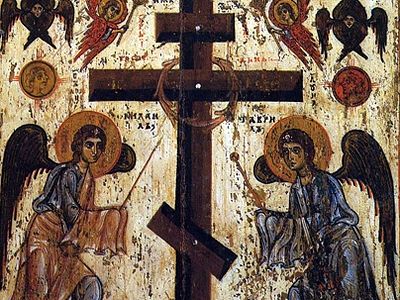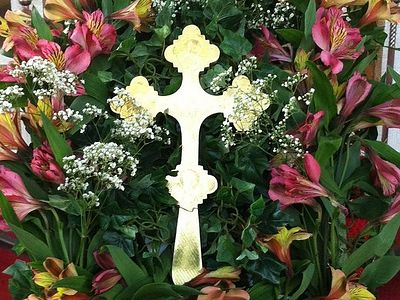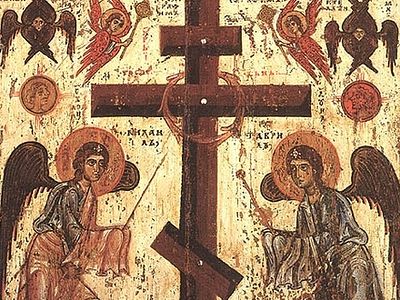This is an article by St. Tikhon, Patriarch of Moscow and All Russia that has never been republished. It was written when he was still an archimandrite at the Kholm theological seminary, which is now located in the territory of Poland, and published in the periodical, Beseda (Discussion), printed in Warsaw. The publication was prepared by senior colleague of the department of recent history of the Russian Orthodox Church of the 20th century in St. Tikhon’s Humanitarian Institute, Natalia Alexandrovna Krivosheyeva.
Now it is Great Lent. The Fourth Week is called the “Veneration of the Cross.” It is so named because on the third Sunday of Great Lent the holy cross is brought out to the center of the church during Matins for veneration by the faithful, and remains there until Friday. Why does the holy Church do this?
When travellers who have travelled a long and difficult road find a large, leafy tree along the way, they sit down beneath its shade, rest there, and after getting relief and gathering strength they continue their way. So does the Church offer the life-bearing tree of the cross of the Lord to those who have passed the time of the fast in ascetic labors and deprivations, for their “relief, cooling, and consolation.”
The time of the fast is a time of increased asceticism and labors of piety. If there is any time when we must crucify our flesh with its passions and lusts, it is Lent. A true fast consists in alienating ourselves from everything bad, restraining our tongues from every idle word, especially corrupt and indecent words, in setting aside hatred and anger, and turning away all fleshly lusts and desires. Turning away from all this should be for us not a fast, not forced labors, but the most appropriate work, bringing peace and joy. However, our nature is prone to sin, and we have trained it to violate the laws, and therefore whoever wants to be free from sins finds this work far from easy. In order to strengthen the Christian in such God-pleasing labors and asceticism, the Church offers the Life-creating Cross of Christ for consolation and encouragement.
We have to war with sin, crucify our passions and lusts, and suffer. But didn’t Christ the Savior lead an arduous battle with the representatives [of evil]—the devil and evil people? Didn’t He suffer from them severely? Wasn’t He crucified? But after all, we suffer for our own sins, we receive what we deserve; but He, the Most Merciful One, suffered not for His sins but for the sins of others, for our human sins!
In order to wrench the “sting of sin” from our flesh, we have to restrain it with fasting, with strict restraint from everything that serves to indulge it. Didn’t Christ fast for forty days, although He possessed a sinless nature? While miraculously feeding others, didn’t He himself hunger and thirst? During the fast the Church more intensively calls us to spend time in vigils and prayer. Didn’t Christ the Savior dedicate all His time away from teaching and helping people to conversing with His Father, to fervent prayer to Him? This means that the way of fasting is the way of Christ, and whoever wants to serve Him should also follow Him; and blessings and glory are promised from Christ to him for this, for “where the cross is, there also is glory.”
And with the understanding of the cross we unite not only the understanding of suffering but also of glory, which comes after sufferings. Thus, on the cross the Savior endured serious sufferings. An innocent One is condemned to a shameful death and is nailed to the cross; crowned with a crown of thorns, and pierced in the side with a spear. He endures mockery and vilification, and experiences terrible torments. But at the same time on the Cross He completes that great work of redeeming people, for which He came to earth, and by which He glorifies not only Himself, but leads others also into the Kingdom of glory, glorifying even the Cross itself. From that time on the cross is no longer the shameful instrument of execution but to the contrary, the dearest and most sacred object for Christians. Therefore Christians also, if they are walking the path of ascetic labors and struggle with sin, if they carry their cross with submission and fervency—that is, various troubles, deprivations, disappointments and the like, let them be comforted: The Kingdom of God is taken by force, and as those who use force to do this, they will with God’s help take it. If they participate in Christ’s sufferings, then they will participate in Christ’s glory; if they die with Him they will also rise with Him.
But the grace-filled power of the Cross of Christ does not bring strengthening and consolation only to those who are “illumined by fasting,” but it can also touch the hearts of those of us who continue even during Lent to lead a sinful, vain life, and awaken them from the heavy sleep of sin. Perhaps a look at the Divine Sufferer, Who endured death on the cross for our sins, will remind those who call themselves Christians that they were baptized with the death of Christ, that they are obligated to serve the Lord and not the world and sin, not their lusts and passions! Perhaps a look at the instrument of the horrible suffering of the Son of God will shake someone’s heart, and produce a saving change in his thoughts and feelings! Perhaps souls will be found, however sinful, but which have not yet reached extreme blindness and hardness of heart, who will return from the church as many did from Golgotha—beating their chests!
May these hopes of the Holy Church come true and be justified, and may the Cross of Christ serve all of us for salvation!




